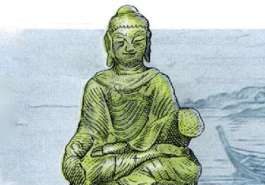Today in China, the Huayan tradition no longer survives as a living institution. The closest one can get is to meet and take refuge under Chan monks who have considerable knowledge of the Huayan jing (Avatamsaka Sutra), or to come across Buddhist organizations that invoke the Huayan tradition. From a more positive angle, one could say that Huayan has always exerted significant influence across the whole of Chinese Buddhism. As one of the two largest surviving “institutional” lineages in China today (alongside Pure Land), Chan has done the most to absorb Huayan thought. This was a process that had been occurring even by the end of the Tang dynasty (618–907), the last imperial dynasty during which Huayan was an active force. During this time, Guifeng Zongmi (780–841) emerged as a notable Chinese Buddhist monk and a significant bridge between Chan and Huayan Buddhism.
Zongmi’s teachings transformed Chinese Buddhism by seeking to reconcile the introspective and experiential methods of Chan with the intellectual and cosmological viewpoints of Huayan. His framework offered a comprehensive approach that emphasises the development of both direct experiential understanding and intellectual exploration of Buddhist teachings. Even today, Buddhists lay and monastic alike straddle both worlds, the meditative and the philosophical. It is an integrated approach that avoids the extremes of both self-denial (the shadow side of meditation) and over-speculation (the shadow side of philosophizing).

The integration of Huayan and Chan in Zongmi’s teachings
Zongmi is acknowledged for his contributions in synthesising the principles of the Huan teaching legacy with the doctrines propagated by the short-lived but influential Heze (菏泽) Chan lineage. The approach proposed by Zongmi might be regarded as a purposeful, pedagogical, and pragmatic synthesis of the doctrines of Chan and Huayan.
The main emphasis lies on the discerning assimilation of the principles of lishi guan (理事觀), the contemplation of fundamental principles and observable facts, and xinshi guan (心識觀), the contemplation of the mind and consciousness. which are credited to the teachings of the Heze lineage (Wang 2019, 149). Zongmi diligently and methodically incorporated these notions within his theoretical framework. The link between these two ideas had a significant influence on succeeding writers. Lishi wuai (理事無礙) and yuanrong wujin (圓融無盡) are concepts prominently featured in the Huayan-Chan texts dating back to the 11th century (Wang, 2019, 149). Furthermore, Zongmi skilfully synthesised several viewpoints about Chan doctrine, including perspectives on practise, alongside Huayan teachings that prioritize theoretical and critical-logical methodologies (such as scriptural exegesis).
Consequently, he formulated what eventually evolved into the “Huayan-Chan” ideology. Drawing from discussions in the Yuanjue jing regarding the yuanjue miaoxin (圓覺妙心) (profound wonderful mind of perfect enlightenment), as well as the traditional Chinese text Dasheng qixin lun (大乘起信論), Zongmi derived inspiration and integrated the teachings of yixin (一心) (one-mind) from Heze Chan and the concepts of lingzhi bumei (靈知不昧) (numinous awareness that is not obscured) and jizhi (knowing stillness) from the zhizhi yizi and zhongmiao zhimen (知之一字,眾妙之門; focus on the one character as the profound doorway) of Chan.
In his works, zhenxin is interchangeably written as zhenshi xin 真實心 (truthful mind), or juedai zhenxin (絕待真心) (absolute sincere mind), lingxin (靈心) (numinous or spiritual mind), yixin (一心) (single/one mind), and more. According to Ran Yunhua, “This concept of zhenshixin represents the highest level of Zongmi’s theoretical framework, and the core of his philosophy.” (Wang 2019, 153)
Zhenxin can further be expanded as zhenshi xin (真實心) (truthful mind), jue-dai zhenxin (絕待真心) (absolute genuine mind), lingxin (靈心) (numinous or spiritual mind), yixin (一心) (representing a single or unified mind), and more. For Ran, zhenshixin encapsulates the pinnacle of Zongmi’s theoretical structure and serves as the fundamental essence of his philosophical perspective.
Classifying the Buddhist teachings
Zongmi’s Chan Preface offers a comprehensive categorization of several Buddhist doctrines, positioning Chan and Huayan as the most elevated tiers within this framework. He proposes that the attainment of ultimate truth necessitates the integration of Chan’s intuitive insight with Huayan’s doctrinal comprehension. According to Peter Gregory, this categorization is based on the belief that Chan and Huayan are interdependent and mutually supportive (Gregory 1991, 280). In both Chan Preface and the Inquiry into the Origin of Man, Zongmi references the Huayan jing as a canonical source to support his depiction of the Buddha’s highest teachings. This particular text holds significant importance within the Chan tradition, as it is believed to contain the initial utterances of the Buddha following his enlightenment. (Gregory 1991, 287)
Zongmi’s teachings pertaining to the practise of meditation demonstrate his inclination towards a synthetic methodology that integrates elements from both the Chan and Huayan traditions. According to Gregory, Zongmi espoused a method that integrates the Chan tradition’s stress on immediate understanding and mindfulness with the Huayan tradition’s focus on the interconnectedness of phenomena and the attainment of “positive” emptiness. (Gregory 1991, 308)

Zongmi’s approach to meditation offers a pragmatic means of building mindfulness, concentration, and insight in a world characterised by rapidity and distraction. This is achieved through the integration of Chan’s emphasis on direct insight and mindfulness, along with Huayan’s emphasis on the interpenetration of all things in the universe. This practice provides individuals with a means to attain a state of inner tranquility and mental clarity in the face of the many difficulties and diversions encountered we encounter in our everyday lives.
Chan frequently highlights the concept of sudden enlightenment. But Zongmi presented a more equitable perspective by asserting that enlightenment should include both a sudden experiential realisation of Buddha-nature (Chan) and a gradual development of wisdom and compassion (Huayan) (Gregory 1991, 281–82). In this sense, Huayan was deeply integrated into Chan, in the name of attaining a comprehensive picture of the nature of Nirvana and the Buddhist path. This habit of syncretism continued far into the future, finding a place in the Liao (918–1125) and Western Xia (1038–1227) empires, the Song dynasty (960–1279), and the entire Ming-Qing period (1368–1911).
Contemporary relevance
Zongmi’s legacy of Huayan-Chan Buddhism enjoys an understated influence in the spiritual landscape of contemporary China. There are echoes of his fusion with China’s relative cultural comfort with syncretism. Overall, it has been a vital tool for understanding and practicing Buddhism. His balanced recognition of the importance of immediate realization and gradual cultivation resonates with practitioners seeking a comprehensive understanding of awakening. This approach emphasizes the integration of different aspects of practice, allowing for a holistic and transformative spiritual journey. Additionally, his work provides a foundation for ecumenical dialogue, allowing for the exchange of ideas and insights between different Buddhist traditions.
Huayan may no longer be an institutional “thing,” and in fact, Huayan-Chan also did not last as a formal school. Still, the thought that animated it has ensured Zongmi’s relevance in the modern world, as his ideas continue to guide Buddhists on their spiritual journeys and deepen their understanding.
References
Gregory, P. N. 1991. “Sudden Enlightenment Followed by Gradual Cultivation: Tsung-mi’s Analysis of mind,” in: R. E. Buswell, and R. M. Gimello (eds.). Paths to Liberation. The Marga and Its Transformations in Buddhist Thought. Honolulu: University of Hawaii Press. 185–214.
S. Wang. 2019. “The Prevalence of Huayan-Chan 華嚴禪 Buddhism in the Regions of Northern China during the 11th Century,” in Journal of Chan Buddhism, 1 (1-2), 146–177. https://doi.org/10.1163/25897179-12340005
See more
圭峰宗密 Guifeng Zongmi (780–841) (terebess.hu)
The Phenomenal Universe of the Flower Ornament Sutra (Lion’s Roar)












